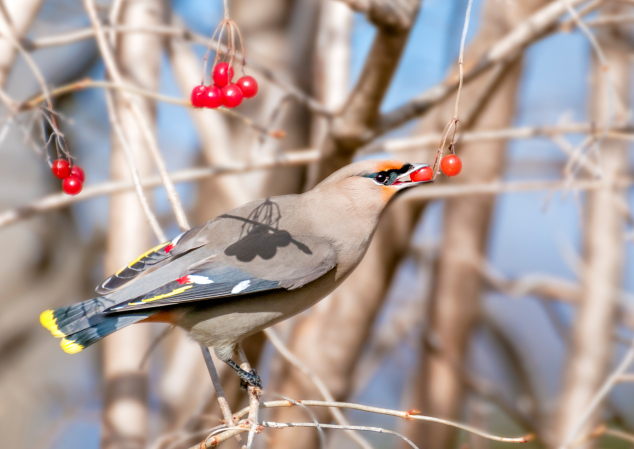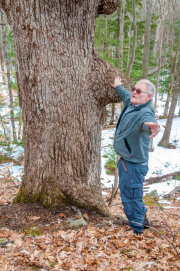Melting snow on Beech Hill reveals a Christmas fern. Inset: The fern’s Christmas-stocking-shaped pinna. Photo: Lee Carvalho
Let’s start off with some rare good news from the natural world.
In late February, the New York Times ran an article about a rebound in the population of monarch butterflies. In a news conference held in Mexico City, the World Wildlife Fund (WWF) said that the cluster of hibernating monarchs in the mountain forests there covered about 10 acres, more than three times the area covered last year.
Another WWF official pointed out that 20 years ago the butterflies filled 45 acres of forest, so the recovery still has a long way to go. Daniel Ashe, director of the U.S. Fish and Wildlife Service suggested “We are seeing the beginning of success… Our task now is to continue building on that success.”
Among the efforts that contributed to the rebound are new plantings of milkweed and efforts to protect the Mexican forests from illegal logging. In the US, there is a drive to replace about 7.5 million acres of milkweed either by planting it or discontinuing the use of pesticides that destroy it. Ashe reported that the milkweed area increased by 250,000 acres last year.
Beech Hill

Closer to home, I’ve been spending a lot of time exploring the top of nearby Beech Hill. On a walk in early March, the conditions were midway between winter and spring. Shady places still sheltered snow and ice, while freshets ran with rain and melt water.
In many places the retreating snow revealed a new favorite of mine: Christmas fern, Polystichum acrostichoides. It’s a favorite because, unlike most of the thousands of species of this ancient plant, I can identify it. Supposedly its name, Christmas fern, derives from the fact that visible parts of the plant remain green year round and therefore can be used in decorations at Christmas time.
However, it is not the only evergreen fern. So how can you identify it for sure? See how each frond has opposite rows of small “leaves”? These are called pinnae. Notice the shape of each pinna: a Christmas stocking! While the rich, green leathery, lance-shaped fronds are crushed on the ground now because of being under heavy snow, soon they will form a fountain-like clump up to two feet tall.

In late February, Frank Baker led his third annual East Andover bushwhack as part of the Sunapee-Ragged-Kearsarge Greenway Coalition’s series of winter hikes. Frank took the group on a four-mile trek into the stream valley north of Elbow pond, where he showed them some big old white oaks and exceptional glacial erratics. The oak measured 134” (circumference at breast height) which puts it near the Merrimack County champ (169”) in Loudon. The group saw plenty of animal sign, especially moose scat and incisor markings on trees.
Remember the irruption of snowy owls in New England two winters ago? A similarly unpredictable invasion was noticed this year by area naturalists who reported vast numbers of bohemian waxwings. These strikingly gorgeous birds breed in Alaska and Canada but often move south when the fruit they depend on becomes scarce.
Their first name comes from their gypsy, or bohemian, nomadic behavior and unpredictable migration pattern. “Waxwing” derives from the waxy red secretions at the tips of their secondaries, the feathers along the inner edge of a bird’s wing, close to the body.
Waxwings look for winter fruit, like crabapples and cranberries, and when they find it, the flock can strip a tree in minutes. Mary Holland tells this story about their susceptibility to alcohol intoxication. “Someone I know … was alarmed when she observed a number of waxwings lying on the ground outside her house, looking for all the world as if they were dead. To her great relief (and disbelief), an hour or two later the ground was bare, the inebriated birds having sobered up and left.”
My thanks to photographer Jim Block for sharing his breathtaking images taken during the recent irruption. If you explore Jim’s Web site at JimBlockPhoto.com, you can see many more images of bohemian waxwings and his slideshow from Frank Baker’s walk in East Andover.